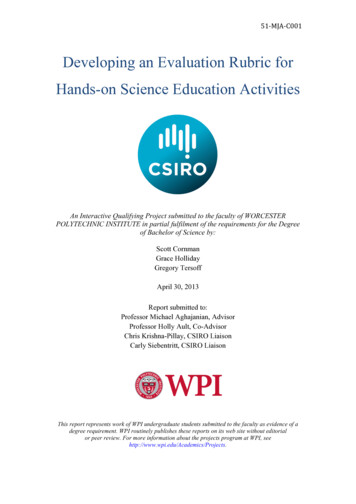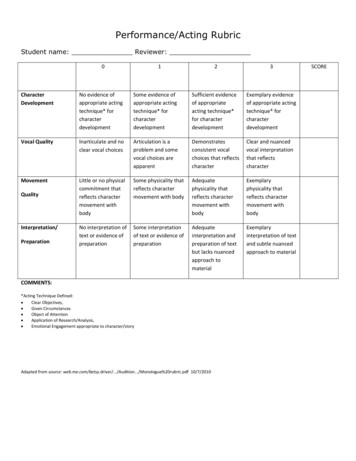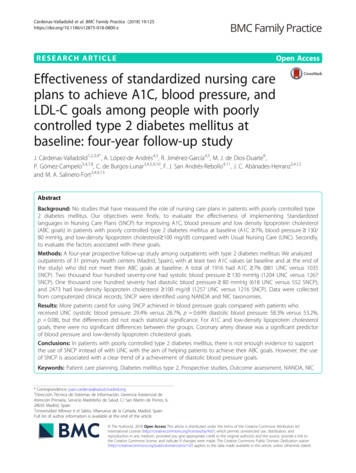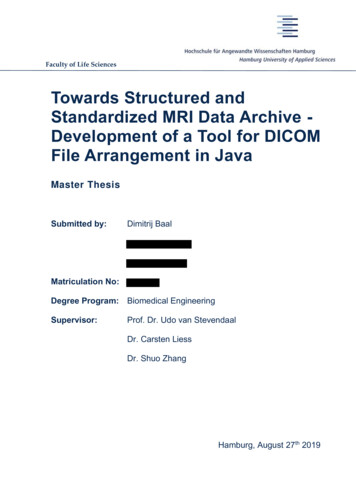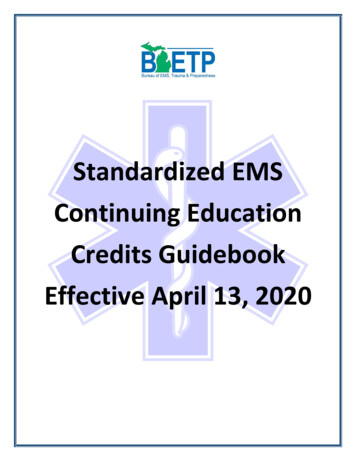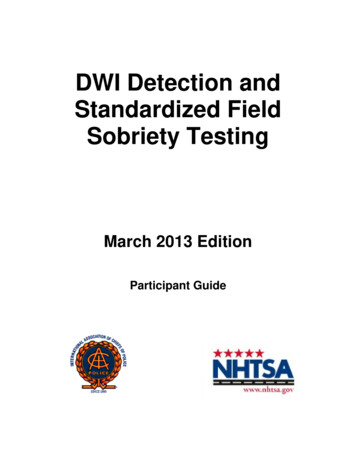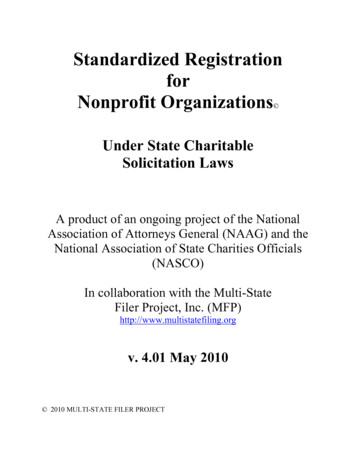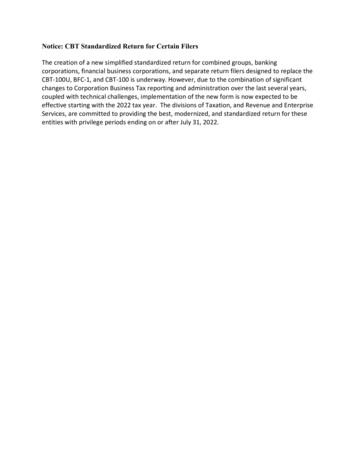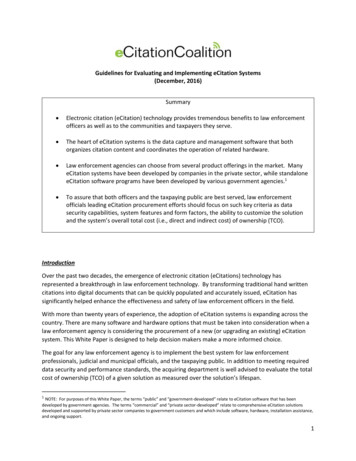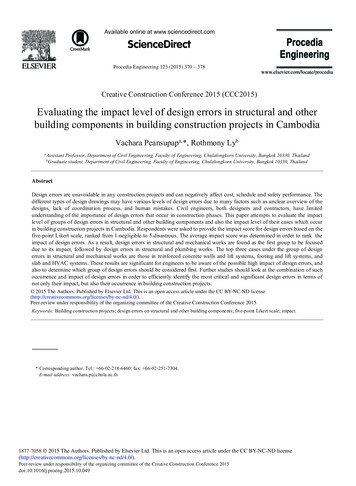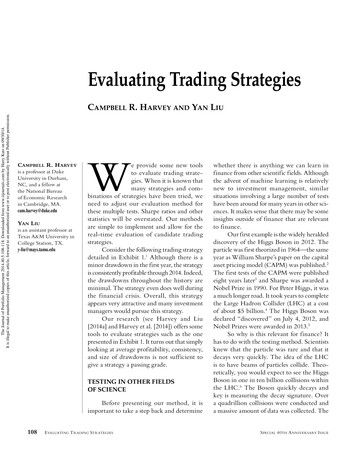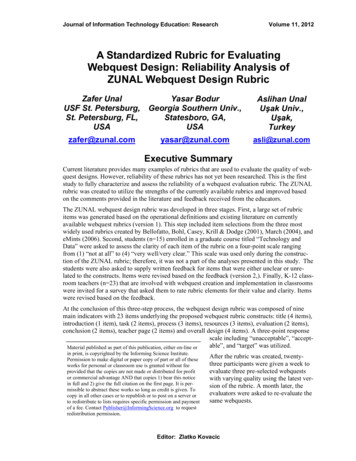
Transcription
Journal of Information Technology Education: ResearchVolume 11, 2012A Standardized Rubric for EvaluatingWebquest Design: Reliability Analysis ofZUNAL Webquest Design RubricZafer UnalUSF St. Petersburg,St. Petersburg, FL,USAYasar BodurGeorgia Southern Univ.,Statesboro, GA,USAAslihan UnalUşak li@zunal.comExecutive SummaryCurrent literature provides many examples of rubrics that are used to evaluate the quality of webquest designs. However, reliability of these rubrics has not yet been researched. This is the firststudy to fully characterize and assess the reliability of a webquest evaluation rubric. The ZUNALrubric was created to utilize the strengths of the currently available rubrics and improved basedon the comments provided in the literature and feedback received from the educators.The ZUNAL webquest design rubric was developed in three stages. First, a large set of rubricitems was generated based on the operational definitions and existing literature on currentlyavailable webquest rubrics (version 1). This step included item selections from the three mostwidely used rubrics created by Bellofatto, Bohl, Casey, Krill & Dodge (2001), March (2004), andeMints (2006). Second, students (n 15) enrolled in a graduate course titled “Technology andData” were asked to assess the clarity of each item of the rubric on a four-point scale rangingfrom (1) “not at all” to (4) “very well/very clear.” This scale was used only during the construction of the ZUNAL rubric; therefore, it was not a part of the analyses presented in this study. Thestudents were also asked to supply written feedback for items that were either unclear or unrelated to the constructs. Items were revised based on the feedback (version 2,). Finally, K-12 classroom teachers (n 23) that are involved with webquest creation and implementation in classroomswere invited for a survey that asked them to rate rubric elements for their value and clarity. Itemswere revised based on the feedback.At the conclusion of this three-step process, the webquest design rubric was composed of ninemain indicators with 23 items underlying the proposed webquest rubric constructs: title (4 items),introduction (1 item), task (2 items), process (3 items), resources (3 items), evaluation (2 items),conclusion (2 items), teacher page (2 items) and overall design (4 items). A three-point responsescale including “unacceptable”, “acceptable”, and “target” was utilized.Material published as part of this publication, either on-line orin print, is copyrighted by the Informing Science Institute.Permission to make digital or paper copy of part or all of theseworks for personal or classroom use is granted without feeprovided that the copies are not made or distributed for profitor commercial advantage AND that copies 1) bear this noticein full and 2) give the full citation on the first page. It is permissible to abstract these works so long as credit is given. Tocopy in all other cases or to republish or to post on a server orto redistribute to lists requires specific permission and paymentof a fee. Contact Publisher@InformingScience.org to requestredistribution permission.After the rubric was created, twentythree participants were given a week toevaluate three pre-selected webquestswith varying quality using the latest version of the rubric. A month later, theevaluators were asked to re-evaluate thesame webquests.Editor: Zlatko Kovacic
Webquest Rubric ReliabilityIn order to investigate the internal consistency and intrarater (test retest) reliability of the ZUNALwebquest design rubric, a series of statistical procedures were employed. The statistical analysesconducted on the ZUNAL webquest rubric pointed to its acceptable reliability. It is reasonable toexpect that the consistency we observed in the rubric scores was due to the comprehensiveness ofthe rubric and clarity of the rubric items and descriptors. Because there are no existing studiesfocusing on reliability of webquests design rubrics, researchers were unable to make comparisonsto discuss the merits of the ZUNAL rubric in relation to others at this point.Keywords: webquest, webquest rubric, rubric reliability analysis, internal consistency, test-retestreliability, interrater reliabilityIntroductionThe webquest concept was developed in 1995 by Bernie Dodge and Tom March with the purposeof leading the teachers to build educational activities taking advantage of the existing resourceson the internet. Rather than simply pointing students to websites which may encourage them to‘copy and paste’, well-structured webquests direct students to internet resources that require theuse of critical thinking skills and a deeper understanding of the subject being explored (March,2003).A webquest is constructed and presented in six parts called building blocks: Introduction, the indication of at least one task, the process through which students will accomplish the task, the Resources where students find the information needed to accomplish the task, the evaluation used toassess the product resulting from students’ work, and a conclusion. An additional section is calledteacher page in which webquest designers provide detailed information regarding webquests suchas curriculum standards, credits, and worksheets (Dodge, 1999). For example, Figure 1 features aFigure 1. A sample webquest from zunal: http://zunal.com/webquest.php?w 4603.170
Unal, Bodur, & Unalwebquest activity in which students are asked to plan a one-week vacation based on a fixedbudget with certain requirements, number of things to do, number of places to visit, etc. At theend of the webquest activity, students are asked to present their vacation plan to the class.According to Dodge (1995, 1997) the webquests can be short term (between one and threeclasses) or long term (from one week to a month). A short term webquest is focused on the acquisition and integration of a certain amount of knowledge by the student. A long term webquestallows a deeper analysis of concepts as well as broadens and reinforces the acquired knowledge.The way a webquest activity is designed discourages students from simply surfing the Web in anunstructured manner. In a webquest, students are given a set of internet sites to visit to collectinformation about a specific topic related to the class curriculum. The teacher gives the class theprocess to follow and the desired result. Once students have collected the necessary information,they evaluate their findings and report to the teacher. As a conclusion, the class reviews the findings and report to the teacher. One thing to keep in mind that Dodge (1995) cautions educators isnot to confuse webquest with “scavenger or treasure hunt” activities. In a scavenger or treasurehunt the questions are predetermined and the answers are static. In a webquest the students aregiven a task in which they will be required to use the information they have. If the task is a scavenger hunt it is not a webquest. A webquest is about what they do with the information collectedfrom the resources.Teachers report that the experience of designing and implementing webquests helps them “discover new resources, sharpen technology skills, and gain new teaching ideas by collaboratingwith colleagues” (Peterson & Koeck, 2001, p. 10). Since webquests challenge student intellectualand academic ability rather than their simple web searching skills, they are said to be capable ofincreasing student motivation and performance (March, 2004), developing students’ collaborativeand critical thinking skills (Perkins & McKnight, 2005; Tran, 2010), and enhancing students’ability to apply what they have learned to new learning (Pohan & Mathison, 1998; Tran, 2010).Many research studies have been conducted to determine the effects of webquests on teachingand learning in many different disciplines and grade levels. It has been indicated that webquestactivities create positive attitudes and perceptions among students (Gorrow, Bing, & Royer, 2004;Tsai, 2006; Unal & Leung, 2010), increase the learners’ motivation (Abbit & Ophus, 2008;Carneiro & Carvalho, 2011; Tsai, 2006), foster collaboration (Barroso & Coutinho, 2010; Bartoshesky & Kortecamp, 2003), enhance problem-solving skills, higher order thinking, and connection to authentic contexts (Abu-Elwan, 2007; Allen & Street, 2007; Lim & Hernandez, 2007),improve students’ reading abilities (Chou, 2011), and assist in bridging the theory to practice gap(Laborda, 2009; Lim & Hernandez, 2007). In addition, teachers reported positively to the value ofthe webquests in their daily teaching (Oliver, 2010; Yang, Tzuo & Komara, 2011).Considering its increasing use, quality of webquests is an important matter. While webquestsshow great promise in enhancing student learning and motivation, the results of using webquestsas teaching and learning tools may depend on how well webquests are designed in the first place.There are thousands of webquests on the internet but the quality of these webquests varies(Dodge, 2001; March, 2003). As a matter of fact, some of them may not be considered as realwebquests (March, 2003). March claims that a good webquest must be able to “prompt the intangible ‘aha’ experiences that lie at the heart of authentic learning” (March, 2003, p. 42). BothDodge and March indicate that a careful evaluation is needed before adapting a webquest to beused in classroom with students (Dodge, 2001; March, 2003). Therefore, careful and comprehensive evaluation of webquest design is an essential step in the decisions of using webquests. Rubrics are “one way to evaluate whether a webquest is well designed. A rubric is a rule or a set ofrules or directions for doing an action as a ritualistic part of a situation (Skovira, 2009). Usingrubrics with scoring criteria can provide meaningful assessment information (Buzzetto-More &171
Webquest Rubric ReliabilityAlade, 2006; Petkov & Petkova, 2006). Providing these rubrics in digital format offered on theweb and connected to a database, the rubrics provide educators with data that can be aggregated(Buzzetto-More, 2006).There are many existing webquest rubrics that are used to judge whether a webquest is well designed however only three rubrics are widely used.Rubric 1. Rubric for Evaluating Webquests by Dodge Dodge (1997) created a rubric for evaluating webquests, which was advanced in Bellofatto et al.(2001). The rubric is designed to evaluate the overall aesthetics, as well as the basic elements of awebquest. Every category is evaluated according to 3 levels; Beginning, Developing, and Accomplished. Every cell is worth a number of points. The teacher can take advantage of all the opportunities afforded on the rubric, score every dimension of the webquest, and come up with ascore out of a total of 50 points that objectifies the usefulness of a webquest (Bellofatto et al.,2001). While this is the most commonly used webquest design evaluation rubric, there have beendiscussions and suggestions regarding the certain elements of it. For example, Maddux andCummings (2007) discussed the lack of focus on the “learner” and recommended the addition of“learner characteristics” to the “Rubric for Evaluating webquests” (Bellofatto et al., 2001). Theyasserted that “ the rubric did not contain any category that would direct a webquest developer toconsider any characteristics of learners, such as ages or cognitive abilities. Instead, the rubric focused entirely on the characteristics of the webquest which does nothing to ensure a match between webquest’s cognitive demands and learner characteristics, cognitive or otherwise” (p. 120).Finally they suggested that care should be taken to ensure that teachers who develop and usewebquests are mindful of students’ individual differences including, but not limited to, age,grade, and cognitive developmental level. To remind teachers of the importance of these considerations, Dodge’s (1997) second item in his list of webquests’s critical attributes should be modified from “a task that is doable and interesting” to “a task that is doable, interesting, and appropriate to the developmental level and other individual differences of students with whom thewebquest will be used” (p. 124).Rubric 2. Webquest Assessment Matrix by March (2004)http://bestwebquests.com/bwq/matrix.aspMarch (2004) created a rubric for evaluating webquest design called Webquest Assessment Matrix. The rubric has eight criteria (Engaging Opening / Writing, the Question/task, background foreveryone, Roles/Expertise, Use of the Web, Transformative Thinking, Real World Feedback, andConclusion). One unique aspect of this evaluation rubric is that it does not have specific criteriafor web elements such as graphics and web publishing. March (2004) suggests that one person'scute animated graphic is another's flashing annoyance. There are 8 categories and every categoryis evaluated according to 3 aspects; Low (1 point), Medium (2 points), and High (3 points). Themaximum score is 24 points. March (2004) also offers a subscription based webquest personalized evaluation/feedback on his official website with the use of this assessment matrix.Rubric 3. eMINTS Rubric seMINTS (enhancing Missouri’s Instructional Networked Teaching Strategies) National Centeralso created a rubric based on Dodge’s work (eMINTS, 2006). Webquest creators are asked touse this rubric to evaluate their webquest design before submitting it for eMINTS evaluation. The172
Unal, Bodur, & UnaleMINTS National Center then evaluates submissions and provides a link to webquests on theirwebsite that score 65 points or higher (Total 70 points possible). This provides authenticity forwebquest creators.As in every assessment tool, a webquest assessment rubric should be independent of who does thescoring and the results similar no matter when and where the evaluation is carried out. The moreconsistent the scores are over different raters and occasions, the more reliable the assessment isthought to be (Moskal & Leydens, 2000). The current literature provides examples of rubrics thatare used to evaluate the quality of webquest design. However, in the current literature, the discussion of reliability analyses of webquest design rubrics is non-existent. This study focuses on reliability analysis of a webquest design evaluation rubric.This article is structured as follows: First a brief overview of rubric reliability and details on different forms of reliability calculations are presented. In the next section, authors describe the specific details on the procedure followed in this study. Next in the results section, the different reliability calculations (internal consistency and intrarater (test-retest)) of the new webquest rubricare provided. The last section outlines the conclusions and future work.Reliability of RubricsThere is “nearly universal” agreement that reliability is an important property in educationalmeasurement (Colton, Gao, Harris, Kolen, Martinovich-Barhite, Wang, & Welch, 1997, p. 3).Many assessment methods require raters to judge or quantify some aspect of student behavior(Stemler, 2004), and Johnson, Penny & Gordon (2000) challenge those who design and implement assessments to strive to achieve high levels of reliability. Ideally, an assessment should beindependent of who does the scoring and the results should be similar no matter when and wherethe assessment is carried out, but this is hardly attainable. The more consistent the scores are overdifferent raters and occasions, the more reliable the assessment is considered (Moskal & Leydens,2000).Two forms of reliability are considered significant. The first form is interrater reliability, whichrefers to the consistency of scores assigned by multiple raters, while the second is intrarater reliability, which refers to the consistency of scores assigned by one rater at different points of time(Moskal, 2000).Interrater reliability refers to “the level of agreement between a particular set of judges on a particular instrument at a particular time” and “provide[s] a statistical estimate of the extent to whichtwo or more judges are applying their ratings in a manner that is predictable and reliable” (Stemler, 2004, p. 3). Raters, or judges, are used when student products or performances cannot bescored objectively as right or wrong but require a rating of degree (Stemler, 2004). This use ofraters results in the subjectivity that comes hand in hand with a rater’s interpretation of the product or performance (Stemler, 2004). Perhaps the most popular statistic for calculating the degreeof consistency between judges is the Pearson correlation coefficient (Stemler, 2004). One beneficial feature of the Pearson correlation coefficient is that the scores on the rating scale can be continuous in nature (e.g., they can take on partial values such as 1.5). Like the percent-agreementstatistic, the Pearson correlation coefficients can be calculated only for one pair of judges at atime and for one item at a time. Values greater than .70 are typically acceptable for consistencyestimates of interrater reliability (Barrett, 2001; Glass & Hopkins, 1996; Stemler, 2004). In situations where multiple judges are used, another approach to computing a consistency estimate ofinterrater reliability would be to compute Cronbach’s alpha coefficient (Crocker & Algina, 1986).Cronbach’s alpha coefficient is used as measure of consistency when evaluating multiple raterson ordered category scales (Bresciani, Zelna, & Anderson, 2009). If the Cronbach’s alpha estimate is low, then this implies that the majority of the variance in the total composite score is173
Webquest Rubric Reliabilityreally due to the error variance, and not the true score variance (Crocker & Algina, 1986). Theinterpretation of Cronbach’s alpha is that it is the expected correlation between pairs of studentscores if we were to choose two random samples of judges and compute two different scores foreach student each based on the judges. Though some authors discourage the assignment ofstrength of reliability scale to this statistic as it is dependent on the number of judges (Cortina,1993), 0.7 is generally considered a satisfactory value of alpha (Nunnally, 1978).Intrarater (test retest) reliability refers to the consistency of scores assigned by one rater at different points of time (Speth, Namuth, & Lee, 2007; Moskal & Leydens, 2000). Unlike measures ofinternal consistency that provide the extent to which all of the questions that make up a scalemeasure the same construct, measures of temporal stability tell you whether or not the instrumentis consistent over time and/or over multiple administrations. The test is performed twice. In thecase of a rubric, this would mean evaluating subjects using the same rubrics by the same group ofevaluators on two different occasions. If the correlation between separate administrations of theevaluation is high, then it is considered to have good test-retest reliability. The test-retest reliability coefficient is simply a Pearson correlation coefficient for the relationship between the totalscores for the two administrations. Additionally, intraclass correlation coefficient (ICC) is usedwhen consistency between ratings from the same raters are evaluated.The following section describes the process through which the webquest evaluation rubric wascreated. After that, results of reliability analyses on the rubric are stated.ProceduresThe rubric was developed in three stages. First, a large set of rubric items was generated based onthe operational definitions and existing literature on currently available webquest rubrics (version1). This step included item selections from the three most widely used rubrics created by Bellofatto et al., (2001), March (2004), and eMints (2006). Second, students (n 15) en
Providing these rubrics in digital format offered on the web and connected to a database, the rubrics provide educators with data that can be aggregated (Buzzetto-More, 2006). There are many existing webquest rubrics that are used to judge whether a webquest is well de-signed how
